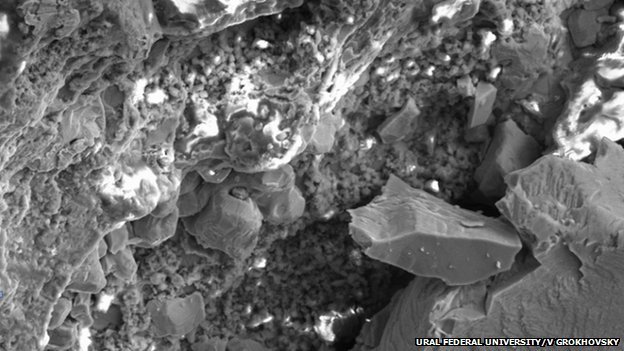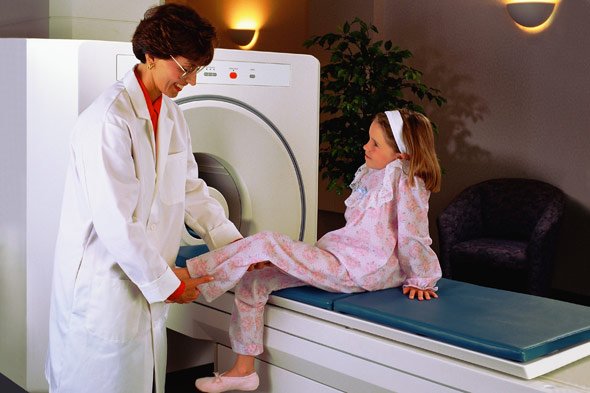Home Tags Posts tagged with "x ray"
x ray
Russian scientists have released microscopic images of fragments of the meteorite that hit the central city of Chelyabinsk in February.
A team from the Ural Federal University was able to analyze some of the dozens of samples as soon as they were found.
But the technique they used allowed them to assess the rock’s chemical make-up at the microscopic level even as they snapped pictures of the fragments.
This will provide extra information on the space rock’s formation and journey.
The fragments represent just a small portion of the remains of the 17m-diameter body that struck the Earth’s atmosphere in a spectacular trail of light over the city of Chelyabinsk.
The team, led by Urals Federal University’s Viktor Grokhovsky, determined right away that the overall chemistry of the meteorite was a familiar “chondrite”.
“The fragments contain a standard number of minerals, including olivine, pyroxene, troilite and kamacite. These minerals that can be discovered only in outer space confirm the fragments’ extraterrestrial nature,” he told the Voice of Russia at the time.
But far more information was in the offing.

Russian scientists have released microscopic images of fragments of the meteorite that hit the central city of Chelyabinsk in February
The team was using a scanning electron microscope, which fires a beam of electrons focused onto a tiny part of a sample, scanning around to see how the electrons are deflected and thereby building up a detailed picture of the sample’s nanometre-scale bumps and valleys.
But that process causes the emission of a small amount of X-ray radiation – with the exact energy of the X-rays corresponding to the chemical element present in the focus of the electron beam.
This is where a silicon drift detector comes in – harvesting these X-rays and determining their energy. The result is a series of what are called X-ray maps – pictures of the same sample showing the presence and quantity of different elements.
It is this understanding of the minerals at a microscopic level that goes far beyond simply telling us what the meteorite is made of, said Simon Burgess of Oxford Instruments, which made the X-max silicon drift detector used by the team.
“For the researchers who are looking at this meteorite, it’s going to be telling them information about which (mineral) phase is associated with which,” he told BBC News.
“When they get into more detail beyond what the main chemistry of the meteorite is, they may be looking at processes in terms of how it formed, the temperature it formed at, what its history has been since its formation, possibly things about what happened to it during its impact with the Earth.
“A lot of that you cannot tell just by crushing it up and getting a ‘bulk analysis’; you have to look at the chemistry of the individual parts and associations between the different minerals in the meteorite.”
The X-max technology is in the running for the Royal Academy of Engineering’s MacRobert Award, to be announced on Friday July 19.
[youtube 9DE8KFLRTf0]
[youtube tq02C_3FvFo]
X-ray has identified a Norwegian tourist sleeping on a moving baggage belt at Rome’s Fiumicino airport.
The unnamed 36 year-old man reportedly climbed over one of the check-in desks and fell asleep on the belt that takes luggage to be loaded on to planes.
When the belt started moving, he travelled for around 50m curled up in the foetal position.

X-ray has identified a Norwegian tourist sleeping on a moving baggage belt at Rome's Fiumicino airport
He apparently remained asleep after staff spotted him in the X-ray machine, stopped the belt and alerted police.
The tourist, who appeared to have been drinking heavily, will now face charges in relation to the incident according to Italy’s La Repubblica newspaper.
The incident has raised questions about security at the airport, but a police spokesperson told the paper that the man could not have got through to secure areas of the airport.
“There is a security system – a sort of roll-up blind – which can only be opened by the member of staff who loads the baggage,” the officer said.
“[The Norwegian] could have carried on going round the main belt but he could never have ended up in sensitive areas of the airport.”
[youtube GOLQ6ajdcDs]
A new study suggests that multiple CT scans in childhood can triple the risk of developing brain cancer or leukaemia.
The Newcastle University-led team examined the NHS medical records of almost 180,000 young patients in UK.
Writing in The Lancet the authors emphasized that the benefits of the scans usually outweighed the risks.
They said the study underlined the fact the scans should only be used when necessary and that ways of cutting their radiation should be pursued.
During a CT (computerized tomography) scan, an X-ray tube rotates around the patient’s body to produce detailed images of internal organs and other parts of the body.
In the first long-term study of its kind, the researchers looked at the records of patients aged under 21 who had CT scans at a range of British hospitals between 1985 and 2002.
Because radiation-related cancer takes time to develop, they examined data on cancer cases and mortality up until 2009.

A new study suggests that multiple CT scans in childhood can triple the risk of developing brain cancer or leukaemia
Brain cancer and leukaemia are rare diseases.
The study estimated that the increased risk translated into one extra case of leukaemia and one extra brain tumour among 10,000 CT head scans of children aged under ten.
Dr. Mark Pearce, an epidemiologist from Newcastle University who led the study, said: “We found significant increases in the risk of leukaemia and brain tumors, following CT in childhood and young adulthood.
“The immediate benefits of CT outweigh the risks in many settings.
“Doses have come down dramatically over time – but we need to do more to reduce them. This should be a priority for the clinical community and manufacturers.”
CT scans are useful for children because anaesthesia and sedation are not required.
This type of check is often ordered after serious accidents, to look for internal injuries, and for finding out more about possible lung disease.
Regulations on their use in the UK mean CT scans should only be done when clinically justified – and the researchers said their study underlined that point.
Professor Sir Alan Craft, a co-author and leading expert in child health, said: “The important thing is that parents can be reassured that if a doctor in the UK suggests a child should have a CT scan, the radiation and cancer risks will have been taken into account.
“There’s a much greater risk of not doing a CT scan when it’s suggested.
“This study will push us to be even more circumspect about using it. We have much stricter rules here about using CT than in the United States, for example.”
Still Life With Meadow Flowers and Roses, a painting once thought to be by Vincent van Gogh but later dismissed has now been confirmed as an authentic work by the Dutch master.
The painting, originally considered a Van Gogh, has belonged to a Dutch museum since 1974.
But doubts crept in due to the painting style and the unusual canvas size and it was discredited in 2003.
However, experts have now authenticated the painting as being a Van Gogh using an X-ray technique.
The painting has now been hung in the Van Gogh section of the Kroeller-Mueller museum in Otterlo for the first time.
The work is thought to have come from the period when Vincent Van Gogh’s lived with his brother Theo in Paris from 1886.
Vincent Van Gogh originally painted a canvas of two wrestlers and then painted Still Life With Meadows and Roses over it.

Vincent Van Gogh originally painted a canvas of two wrestlers and then painted Still Life With Meadows and Roses over it
Using a new X-ray technique, researchers examined the two wrestlers in more detail.
The brush strokes and pigments pointed to Vincent Van Gogh.
Researchers also discovered the large canvas was a standard format for figure paintings at the Antwerp academy where Van Gogh studied at the time.
A senior researcher at Amsterdam’s Van Gogh Museum, Louis van Tilborgh, took part in the study.
Louis van Tilborgh said the wrestlers posing half-naked in the original painting was characteristic of the Antwerp academy at the time.
Vincent Van Gogh also wrote to his brother saying that he was pleased with how the wrestler painting had turned out.
But Van Gogh later painted directly over it which experts say accounts for the “uncharacteristic exuberance” of the floral still life.




